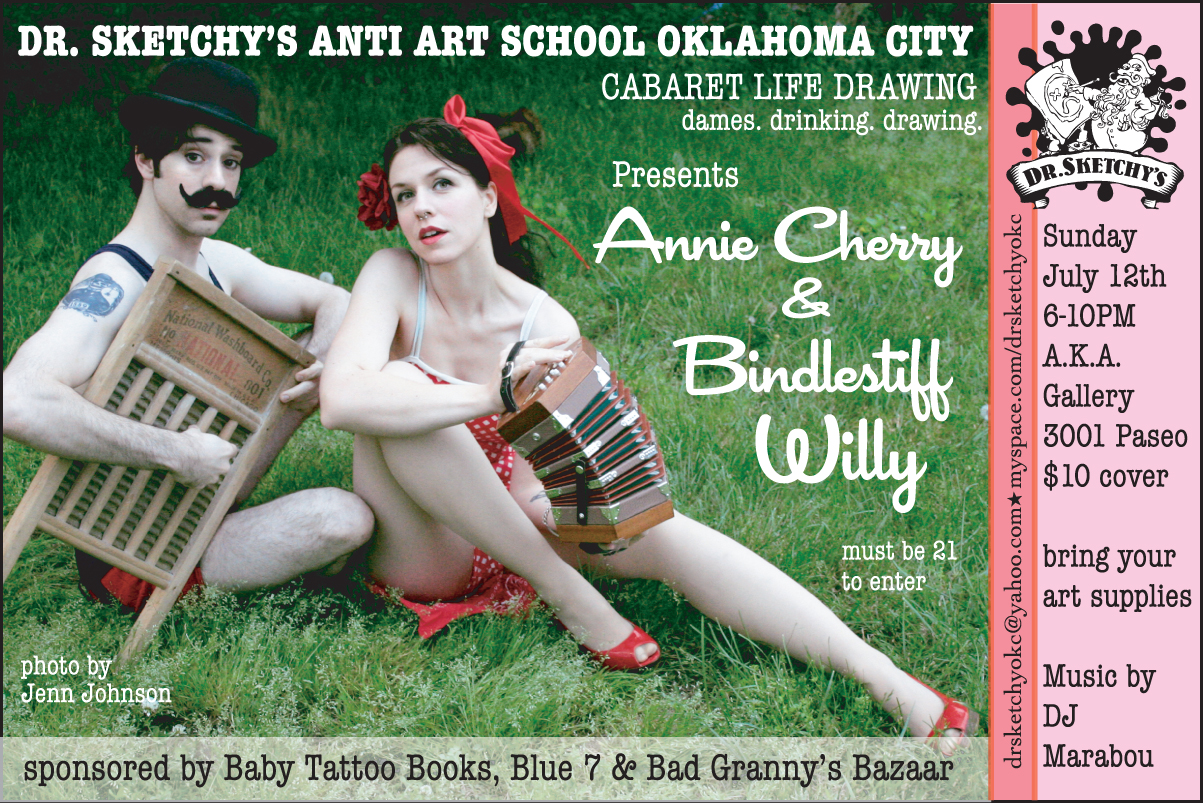Gary Panter at the Philbrook Museum 2009.07.16
Oklahoma native Gary Panter will appear at the Philbrook Museum this Thursday evening from 5 to 8 pm. He will do a live painting from 5 to 6:30 pm, followed by a Q&A and a book signing. I have an appointment to promote Back to Normal on television that evening, otherwise I would go! So please tell me how it went.
Gary Panter is among the pioneers of Lowbrow art, though he is perhaps best known for having designed the sets for Pee Wee's Playhouse. Read his full bio here.
Normal Gallery Talk and 24 Works on Paper 2009.07.18

Normal, OK: Goodnight McBride, ink and prismacolor pencil on paper, 2008.
I'll be appearing at two OKC gallery events this coming Saturday, July 18. First is my gallery talk and book signing for Back to Normal at the Gaylord-Pickens Museum (map here). I'll speak from 2 pm until whenever we get tired of eachother. There will be audience participation, followed by lemonade!
Afterward, head over to IAO Gallery at 811 N Broadway for the 24 Works on Paper opening. There you can mingle, and see my drawing of romy, plus 23 other works by Oklahoma artists. IAO is the first venue for this travelling show. Kick off the tour with us from 6 to 9 pm.
Found on Flickr: In Extasis by Tim Lowly

In Extasis, acrylic on panel, 2002 by Tim Lowly. Click image to view source.
Once again, I celebrate Flickr as a showcase for emerging and established artists alike, in all visual media. This wonderful painting by Tim Lowly (his website is here) is accompanied by a description written by Karen Halvorsen-Screck in 2002. You can read the full essay here, but this is my favorite part:
In Ekstasis, for instance, seems to reveal one of Temma's fleeting expressions of happiness, or what appears to be happiness. I know that she is cortically blind, yet here I see her seeing something above and beyond me and my ken. In fact, she appears to be gazing at radiance, or releasing a radiance within. It is impossible to know for sure, and much of my response to In Ekstasis depends on my emotional perspective in the moment of looking.
I got the same feeling looking at this image, the feeling that I was seeing someone seeing something that I don't see. It reminds me of that fundamental paradox of portraiture, that the inanimate image of the subject is a reflection of my own act of seeing.
Tim Lowly is represented by Koplin Del Rio Gallery in Culver City, California.
See what else I've Found on Flickr.
This post is part of NaBloPoMo for July 2009.
End Matter - Finishing Touches on a Gallery Show

Aloe polyphylla Schönland ex Pillans by Flickr user brewbooks. Click image to view source.
End matter or back matter is a book publishing term that describes all the written elements of a book to be dealt with after the author has finished writing the manuscript. These may include indexes, appendices, glossaries, the table of contents, notes, bibliographies, and so on.
As a gallery artist, I have learned to do a lot more legwork besides making the paintings. I have come to think of certain tasks as the end matter -- what remains to be done after the art is finished. The more of this work I do myself, and do well, before delivering my work to a gallery, the better my professional standing.
Following is some end matter I'm faced with before a gallery show.
Sign and date the work. Sometimes, as with the Normal series, I include a story on the back of the piece. Information like this can increase a painting's value and provenance.
Prepare the painting for hanging in the gallery, either by wiring or framing. I highly recommend Downtown Art & Frame in Norman, OK.
Attach a business card or other identifying information to the back of the piece. This is especially important for group shows where your work might be misidentified.
Photograph the piece. That is, take a good photo, not one with uneven lighting, or glare, or out of focus, etc. The digital formats I use most often are: 300 dpi, 1,000 pixels on a side (for print) 300 dpi, 4 x 6 inches or thereabouts (for print or application to juried shows) 72 dpi, 500-800 pixels on a side (for the web) 72 dpi, 150 pixels on a side (for thumbnails)
Make a backup of the photos, on cd, on the home server, etc.
Upload the image to my website, Flickr, Facebook, etc.
Add the piece to my portfolio, if it's among my best works. Add the piece to my inventory. I'll post more on this later.
Register the work with the copyright office. I keep a text file with an ongoing list of all the works I complete, called "Works By Date." When I finish a piece (or scan a batch of sketchbook pages), I add it to the list. I also keep a folder of small images at 72 dpi, which I will submit as a batch with my copyright registration. When I'm on top of things, I register my work four times a year.
Create an inventory for the gallery. This is so underrated. I make the inventory in two formats:
A spreadsheet containing the title and dates of the show, then the title, medium, dimensions, year, and price for each piece. At the bottom of the spreadsheet I list the show drop-off and pick-up dates, with space for my initials and the curator's. I print two copies: one for me, one for them.
A visual inventory with thumbnail images of each work in the show, followed by titles and prices. (Again, I print two or more copies, and file one for my own reference.) This helps whomever hangs and labels the show, and can also facilitate sales. When a potential buyer calls the gallery asking for the price of a piece, they may only remember it as "That yellow one, with the guy, and that thing in the corner." Having a visual inventory on hand can help avoid all sorts of confusion.
I've learned to leave myself a few days before my deadline to tie up these loose ends. When it's time to ship or deliver my work, I feel much better having all these ducks are in a row.
This post is part of NaBloPoMo for July 2009.
Dr. Sketchy's with Annie Cherry & Bindlestiff Willie 2009.07.12

Come on out to Dr. Sketchy's Anti Art School this Sunday evening at aka gallery. Our featured models this week are Annie Cherry and Bindlestiff Willie. It's getting pretty crowded, so bring a chair!
Dr. Whatskies? Click here to learn more. You do this in Oklahoma City? Yes, yes we do.
This post is part of NaBloPoMo for July 2009.

